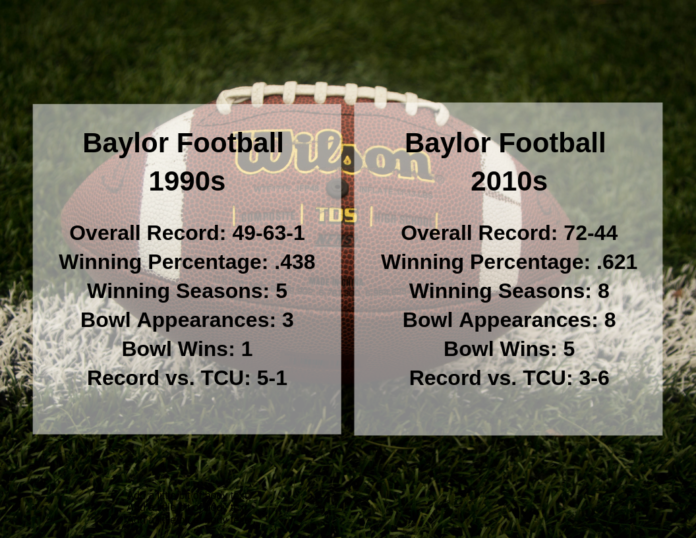
By Jessika Harkay | Sports Writer
The early ’90s were a special time for Texas football. Professionally, from 1993-1996, the Dallas Cowboys won three Super Bowls under head coach Jimmy Johnson. For Baylor, the Bears in 1990-1995 were only below .500 once and went to three bowl games.
Under head coach Grant Teaff, who coached at Baylor for 21 years and retired in the early ’90s, the Bears went to eight bowl games, two of which were back-to-back in 1991 and 1992. After Teaff’s retirement, under head coach Chuck Reedy, the Bears clinched the Southwest Conference title and made an appearance in the 1994 Alamo Bowl against Washington State.
Though the early and mid ’90s marked points of success and momentum in the program, the Bears would later take a dip and struggle – only winning nine of 35 games in a four-year period.
After Teaff and Reedy’s early ’90s success, the Bears would undergo three coaching changes in a ten-year time frame from 1997-2007. Unable to break .500 until 2010, the Baylor football program wasn’t the same.
Looking back at the program’s history, there are many parallels in correlation to our Bears now. The early ’90s success mirrors the Art Briles era, specifically from 2010-15 where the Bears made a bowl every year and averaged a .731 winning percentage.
The Bears’ 2010s success would be halted after the 2012-2016 sexual assault scandal came to light.
An entirely new coaching staff and reconstruction of the program would leave the Bears to fall to 1-11 in the 2017 season. Similar to the 1996-1999 seasons that averaged a .205 winning percentage, the Bears would struggle as they adapted to a new program.
Unlike the late ’90s, the Bears had a quick turnaround, going 7-6 the following season and pulling off a win in the Texas Bowl under head coach Matt Rhule.
Teaff said there are many similarities between the team he coached and the one that is developing now.
“I’m a fundamentalist, so we were very very intent about penalties, not getting penalties, not turning the ball over, those basic things. I see and sense that from Coach Rhule,” Teaff said. “I think there’s many similarities between their philosophy and the philosophy that we had. The relationship we have with the players seems to be very strong with Coach Rhule and his staff as well. The demanding of excellence in the classroom and in the community and on the football field seems to be very very similar.”
On the other hand, unlike the Bears now, the 1996 team had to adapt from moving from the Southwest Conference to the Big 12, ultimately resulting in newer opponents and different competition. Jerry Hill, Baylor’s director of sports journalism, who has been covering Baylor sports for over 30 years, described the shift in conferences as the main reason for the ’90s dip.
“The biggest thing was adjusting to the Big 12. I think there was a stretch of where they didn’t win more than one conference game until maybe the late 2000s when Coach Briles came in,” Hill said. “Obviously the dip in 2017 was somewhat the same thing with coaching changes and just everything the program has gone through, losing recruits. There was a little bit of that in the ’90s. … In 2017, that was of course Matt Rhule’s first year and there was some adjustments in there, as well going into a completely different style in offense and defense.”
Another point of change was the shift from being football oriented to focusing more on academics. In the late ’90s, the program was more directed toward being a successful athlete rather than a student. Hill especially noted the Reedy era for a time where athletics were focused solely on sports.
“One of the knocks against Coach Reedy is that he recruited a bunch of guys that never got eligible,” Hill said. “There were a lot of guys that would never make it in school.”
One thing Rhule has made clear in his coaching style is emphasizing school first.
“One of the things I’m proud of is we’re not one of those schools that cluster guys into one major. Our guys are in over 33 different majors,” Rhule said. “I don’t ever want a person to make a decision between class and practice, and if they do, they’re going to pick class. I don’t want them to shy away from a major because they can’t do it.”
Something that didn’t change throughout years, though, is the famous Texas Christian school rivalry.
The battle of the Christian schools – Baylor and Texas Christian University – dates back to 1899 and is a fan favorite. Throughout 1990-1995, the Bears defeated the Frogs in five of six matchups.
After joining separate conferences in 1996, the matchup took a hiatus and didn’t resurface until 2006. Since 2006, the Frogs have won eight of 11 matchups and lead the rivalry 55-52-7 as of 2018.
Going forward, Teaff gave a few pieces of advice for the team that were the key to success during his era.
“It boils down to four basic things. I call them mind controls, because as humans we can control many aspects of our lives […] Number one is attitude. You have to approach life with a positive attitude. It can’t just be one day; it has to be every day, ” Teaff said. “The second one is total effort. Whatever you do, whether it’s in the classroom or city streets or football field, if you give total effort, every way on every play, then it’s going to be very hard for you not to be successful. The third thing is self-discipline, self-control. We as human beings have that. […] The fourth thing I believe in is the power of love. […] If you’re going to play the game, you have to love the game.”





